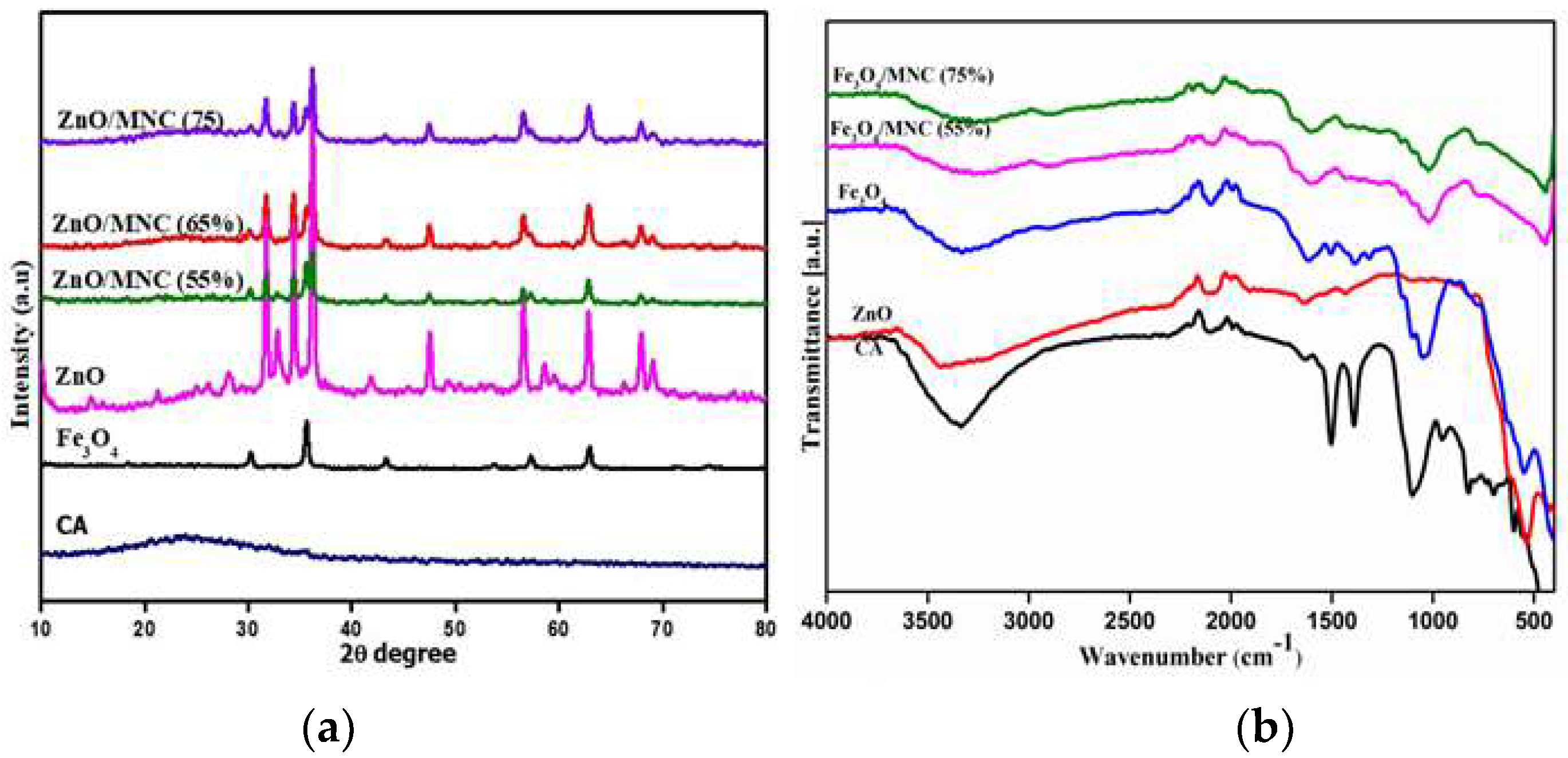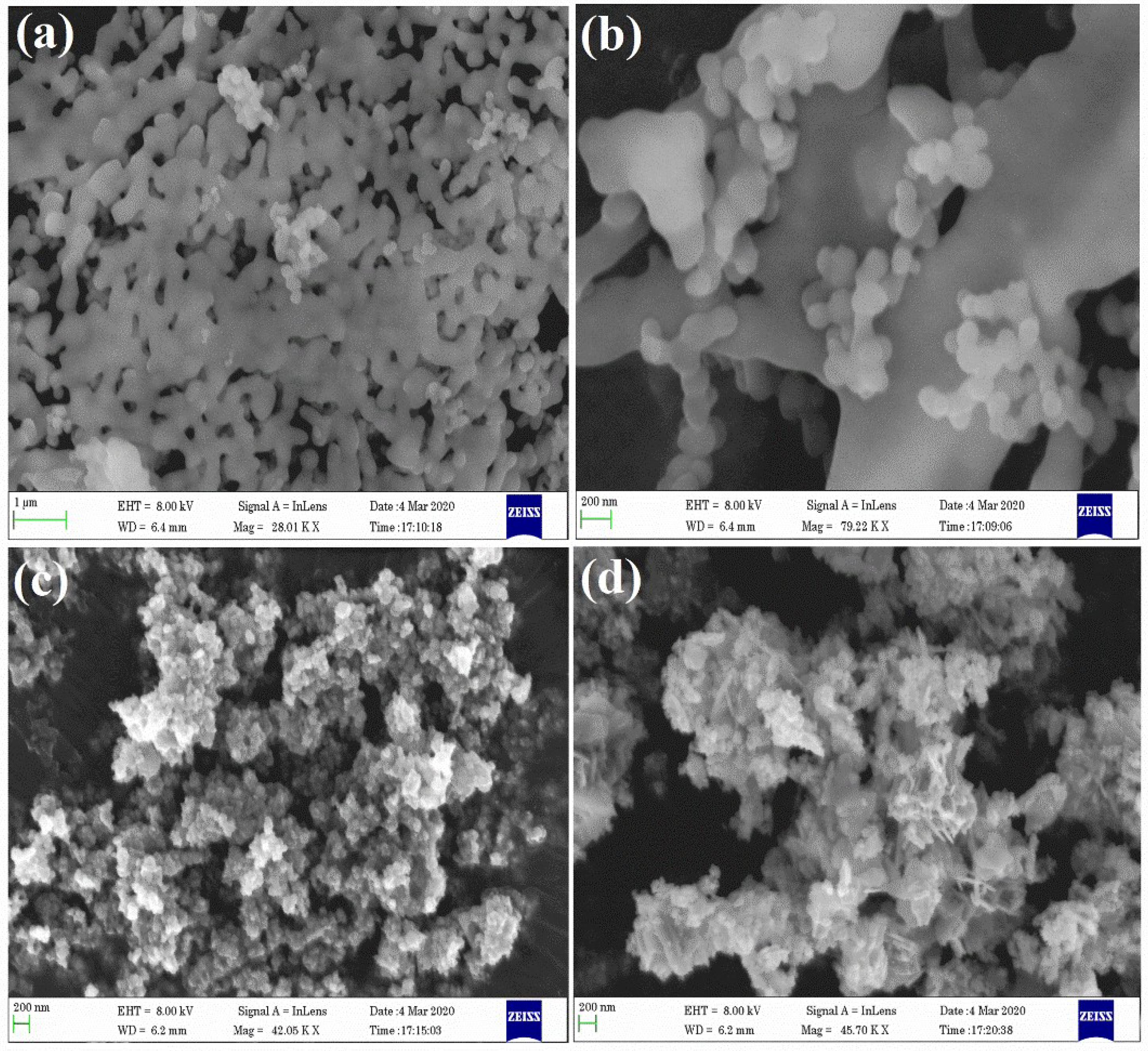Magnetically Recoverable Biomass-Derived Carbon-Aerogel Supported ZnO (ZnO/MNC) Composites for the Photodegradation of Methylene Blue
Abstract
:1. Introduction
2. Experimental Section
2.1. Materials Required
2.2. Preparation Magnetic ZnO/MNC Composites
2.3. Photocatalytic Study
2.4. Characterization
3. Results and Discussion
3.1. Characterization of ZnO/MNC Composite Photocatalysts
3.2. Photophysical Properties
3.3. Photocatalytic Study
3.4. Recycling Efficiency of the ZnO/MNC (75%)
3.5. Mechanism
4. Conclusions
Author Contributions
Funding
Data Availability Statement
Acknowledgments
Conflicts of Interest
References
- Smol, M.; Kulczycka, J.; Henclik, A.; Gorazda, K.; Wzorek, Z. The Possible Use of Sewage Sludge Ash (SSA) in the Construction Industry as a Way towards a Circular Economy. J. Clean. Prod. 2015, 95, 45–54. [Google Scholar] [CrossRef]
- Velusamy, S.; Roy, A.; Sundaram, S.; Kumar Mallick, T. A Review on Heavy Metal Ions and Containing Dyes Removal Through Graphene Oxide-Based Adsorption Strategies for Textile Wastewater Treatment. Chem. Rec. 2021, 21, 1570–1610. [Google Scholar] [CrossRef]
- Reddy, N.; Chen, L.; Zhang, Y.; Yang, Y. Reducing Environmental Pollution of the Textile Industry Using Keratin as Alternative Sizing Agent to Poly(Vinyl Alcohol). J. Clean. Prod. 2014, 65, 561–567. [Google Scholar] [CrossRef]
- Prabhakar, U.P.S.; Helina, J.K.A.J.; Sagayaraj, Y.V. Synthesis, Characterization and Biological Activity of 2-[(2-Hydroxy-Phenylimino)-Methyl]-6-Methoxy-Phenol (MSAP) and Nano Sized of Co (II), Ni (II), Cu (II) and Zn (II) Metal Complexes. Mater. Today Proc. 2021, 47, 1952–1959. [Google Scholar] [CrossRef]
- Ngullie, R.C.; Alaswad, S.O.; Bhuvaneswari, K.; Shanmugam, P.; Pazhanivel, T.; Arunachalam, P. Synthesis and Characterization of Efficient ZnO/g-C3N4 Nanocomposites Photocatalyst for Photocatalytic Degradation of Methylene Blue. Coatings 2020, 10, 500. [Google Scholar] [CrossRef]
- Prasad, S.; Shanmugam, P.; Bhuvaneswari, K.; Palanisamy, G.; Pazhanivel, T.; Arunkumar, T.; AlSalhi, M.S.; Aljaafreh, M.J. Rod-Shaped Carbon Aerogel-Assisted CdS Nanocomposite for the Removal of Methylene Blue Dye and Colorless Phenol. Crystals 2020, 10, 300. [Google Scholar] [CrossRef]
- Rajeshwar, K.; Osugi, M.E.; Chanmanee, W.; Chenthamarakshan, C.R.; Zanoni, M.V.B.; Kajitvichyanukul, P.; Krishnan-Ayer, R. Heterogeneous Photocatalytic Treatment of Organic Dyes in Air and Aqueous Media. J. Photochem. Photobiol. C Photochem. Rev. 2008, 9, 171–192. [Google Scholar] [CrossRef]
- Malathi, A.; Madhavan, J.; Ashokkumar, M.; Arunachalam, P. A Review on BiVO4 Photocatalyst: Activity Enhancement Methods for Solar Photocatalytic Applications. Appl. Catal. A Gen. 2018, 555, 47–74. [Google Scholar] [CrossRef]
- Theerthagiri, J.; Salla, S.; Senthil, R.A.; Nithyadharseni, P.; Madankumar, A.; Arunachalam, P.; Maiyalagan, T.; Kim, H.-S. A Review on ZnO Nanostructured Materials: Energy, Environmental and Biological Applications. Nanotechnology 2019, 30, 392001. [Google Scholar] [CrossRef]
- Alshorifi, F.; Ali, S.; Salama, R. Promotional Synergistic Effect of Cs-Au NPs on the Performance of Cs-Au/MgFe2O4 Catalysts in Catalysis 3,4-Dihydropyrimidin-2(1H)-Ones and Degradation of RhB Dye. J. Inorg. Organomet. Polym. Mater. 2022. [Google Scholar] [CrossRef]
- Singh, R.; Barman, P.B.; Sharma, D. Synthesis, Structural and Optical Properties of Ag Doped ZnO Nanoparticles with Enhanced Photocatalytic Properties by Photo Degradation of Organic Dyes. J. Mater. Sci. Mater. Electron. 2017, 28, 5705–5717. [Google Scholar] [CrossRef]
- Sakthivel, S.; Neppolian, B.; Shankar, M.V.; Arabindoo, B.; Palanichamy, M.; Murugesan, V. Solar Photocatalytic Degradation of Azo Dye: Comparison of Photocatalytic Efficiency of ZnO and TiO2. Sol. Energy Mater. Sol. Cells 2003, 77, 65–82. [Google Scholar] [CrossRef]
- Lu, J.; Hu, H.; Yang, S.; Shanmugam, P.; Wei, W.; Selvaraj, M.; Xie, J. ZnS@carbonaceous Aerogel Composites Fabricated in Production of Hydrogen and for Removal of Organic Pollutants. J. Mater. Sci. Mater. Electron. 2018, 29, 8523–8534. [Google Scholar] [CrossRef]
- Shi, M.; Wei, W.; Jiang, Z.; Han, H.; Gao, J.; Xie, J. Biomass-Derived Multifunctional TiO2/Carbonaceous Aerogel Composite as a Highly Efficient Photocatalyst. RSC Adv. 2016, 6, 25255–25266. [Google Scholar] [CrossRef]
- Shanmugam, P.; Murthy, A.P.; Theerthagiri, J.; Wei, W.; Madhavan, J.; Kim, H.-S.; Maiyalagan, T.; Xie, J. Robust Bifunctional Catalytic Activities of N-Doped Carbon Aerogel-Nickel Composites for Electrocatalytic Hydrogen Evolution and Hydrogenation of Nitrocompounds. Int. J. Hydrogren Energy 2019, 44, 13334–13344. [Google Scholar] [CrossRef]
- Altass, H.M.; Morad, M.; Khder, A.E.-R.S.; Mannaa, M.A.; Jassas, R.S.; Alsimaree, A.A.; Ahmed, S.A.; Salama, R.S. Enhanced Catalytic Activity for CO Oxidation by Highly Active Pd Nanoparticles Supported on Reduced Graphene Oxide/Copper Metal Organic Framework. J. Taiwan Inst. Chem. Eng. 2021, 128, 194–208. [Google Scholar] [CrossRef]
- Uddin, M.T.; Nicolas, Y.; Olivier, C.; Toupance, T.; Servant, L.; Müller, M.M.; Kleebe, H.-J.; Ziegler, J.; Jaegermann, W. Nanostructured SnO2-ZnO Heterojunction Photocatalysts Showing Enhanced Photocatalytic Activity for the Degradation of Organic Dyes. Inorg. Chem. 2012, 51, 7764–7773. [Google Scholar] [CrossRef]
- Lai, C.-H.; Lu, M.-Y.; Chen, L.-J. Metal Sulfide Nanostructures: Synthesis, Properties and Applications in Energy Conversion and Storage. J. Mater. Chem. 2011, 22, 19–30. [Google Scholar] [CrossRef]
- Murugan, E.; Shanmugam, P. Efficient Functionalization of Poly(Styrene) Beads Immobilized Metal Nanoparticle Catalysts for the Reduction of Crystal Violet. Bull. Mater. Sci. 2015, 38, 629–637. [Google Scholar] [CrossRef]
- Murugan, E.; Shanmugam, P. Surface Grafted Hyper-Branched Polyglycerol Stabilized Ag and AuNPs Heterogeneous Catalysts for Efficient Reduction of Congo Red. J. Nanosci. Nanotechnol. 2016, 16, 426–438. [Google Scholar] [CrossRef]
- Ngullie, R.C.; Shanmugam, P.; Mahmoud, M.H.; Prabhakar, U.P.S.; Kumari, M.A.; Akhtar, M.S. Fabrication of Biomass Derived Carbon Supported Iron Oxide Composites for Antibacterial and Antifungal Activity. Mater. Lett. 2022, 312, 131664. [Google Scholar] [CrossRef]
- Alshorifi, F.T.; Alswat, A.A.; Mannaa, M.A.; Alotaibi, M.T.; El-Bahy, S.M.; Salama, R.S. Facile and Green Synthesis of Silver Quantum Dots Immobilized onto a Polymeric CTS-PEO Blend for the Photocatalytic Degradation of p-Nitrophenol. ACS Omega 2021, 6, 30432–30441. [Google Scholar] [CrossRef]
- Jayaraman, T.; Raja, S.A.; Priya, A.; Jagannathan, M.; Ashokkumar, M. Synthesis of a Visible-Light Active V2O5-g-C3N4 Heterojunction as an Efficient Photocatalytic and Photoelectrochemical Material. New J. Chem. 2015, 39, 1367–1374. [Google Scholar] [CrossRef]
- Theerthagiri, J.; Senthil, R.A.; Priya, A.; Madhavan, J.; Michael, R.J.V.; Ashokkumar, M. Photocatalytic and Photoelectrochemical Studies of Visible-Light Active α-Fe2O3-g-C3N4 Nanocomposites. RSC Adv. 2014, 4, 38222–38229. [Google Scholar] [CrossRef]
- Shanmugam, P.; Wei, W.; Qian, K.; Jiang, Z.; Lu, J.; Xie, J. Efficient Removal of Erichrome Black T with Biomass-Derived Magnetic Carbonaceous Aerogel Sponge. Mater. Sci. Eng. B 2019, 248, 114387. [Google Scholar] [CrossRef]
- Xu, Y.; Sheng, K.; Li, C.; Shi, G. Self-Assembled Graphene Hydrogel via a One-Step Hydrothermal Process. ACS Nano 2010, 4, 4324–4330. Available online: https://pubs.acs.org/doi/10.1021/nn101187z (accessed on 4 September 2022). [CrossRef]
- Carbon Aerogel: An Overview. ScienceDirect Topics. Available online: https://www.sciencedirect.com/topics/engineering/carbon-aerogel (accessed on 4 September 2022).
- Han, J.; Johnson, I.; Chen, M. 3D Continuously Porous Graphene for Energy Applications. Adv. Mater. 2022, 34, 2108750. [Google Scholar] [CrossRef]
- Lu, X.; Nilsson, O.; Fricke, J.; Pekala, R.W. Thermal and Electrical Conductivity of Monolithic Carbon Aerogels. J. Appl. Phys. 1993, 73, 581–584. Available online: https://aip.scitation.org/doi/10.1063/1.353367 (accessed on 4 September 2022). [CrossRef]
- Yamamoto, M.; Zhao, Q.; Goto, S.; Gu, Y.; Toriyama, T.; Yamamoto, T.; Nishihara, H.; Aziz, A.; Crespo-Otero, R.; Tommaso, D.D.; et al. Porous Nanographene Formation on γ-Alumina Nanoparticles via Transition-Metal-Free Methane Activation. Chem. Sci. 2022, 13, 3140–3146. [Google Scholar] [CrossRef]
- El-Hakam, S.A.; ALShorifi, F.T.; Salama, R.S.; Gamal, S.; El-Yazeed, W.S.A.; Ibrahim, A.A.; Ahmed, A.I. Application of Nanostructured Mesoporous Silica/Bismuth Vanadate Composite Catalysts for the Degradation of Methylene Blue and Brilliant Green. J. Mater. Res. Technol. 2022, 18, 1963–1976. [Google Scholar] [CrossRef]
- Jin, Y.; Wu, M.; Zhao, G.; Li, M. Photocatalysis-Enhanced Electrosorption Process for Degradation of High-Concentration Dye Wastewater on TiO2/Carbon Aerogel. Chem. Eng. J. 2011, 168, 1248–1255. [Google Scholar] [CrossRef]
- Alshorifi, F.T.; Alswat, A.A.; Salama, R.S. Gold-Selenide Quantum Dots Supported onto Cesium Ferrite Nanocomposites for the Efficient Degradation of Rhodamine B. Heliyon 2022, 8, e09652. [Google Scholar] [CrossRef] [PubMed]
- Foroughi, M.M.; Jahani, S.; Aramesh-Boroujeni, Z.; Fathabadi, M.V.; Rafsanjani, H.H.; Dolatabad, M.R. Template-Free Synthesis of ZnO/Fe3O4/Carbon Magnetic Nanocomposite: Nanotubes with Hexagonal Cross Sections and Their Electrocatalytic Property for Simultaneous Determination of Oxymorphone and Heroin. Microchem. J. 2021, 170, 106679. [Google Scholar] [CrossRef]
- Shi, G.; Liu, C.; Wang, G.; Chen, X.; Li, L.; Jiang, X.; Zhang, P.; Dong, Y.; Jia, S.; Tian, H.; et al. Preparation and Electrochemical Performance of Electrospun Biomass-Based Activated Carbon Nanofibers. Ionics 2019, 25, 1907–1914. [Google Scholar] [CrossRef]
- Vijayalakshmi, D.; Chellappa, M.; Anjaneyulu, U.; Manivasagam, G.; Sethu, S. Influence of Coating Parameter and Sintering Atmosphere on the Corrosion Resistance Behavior of Electrophoretically Deposited Composite Coatings. Mater. Manuf. Process. 2015, 31, 95–106. [Google Scholar] [CrossRef]
- Jayarambabu, N. Germination and Growth Characteristics of Mungbean Seeds (Vigna radiata L.) Affected by Synthesized Zinc Oxide Nanoparticles. Int. J. Curr. Eng. Technol. 2014, 4, 5. [Google Scholar]
- Gunes, H.; Özbakir, Y.; Barim, S.B.; Yousefzadeh, H.; Bozbag, S.E.; Erkey, C. A Remarkable Class of Nanocomposites: Aerogel Supported Bimetallic Nanoparticles. Front. Mater. 2020, 7, 18. [Google Scholar] [CrossRef]
- Abdolhosseinzadeh, S.; Asgharzadeh, H.; Sadighikia, S.; Khataee, A. UV-Assisted Synthesis of Reduced Graphene Oxide–ZnO Nanorod Composites Immobilized on Zn Foil with Enhanced Photocatalytic Performance. Res. Chem. Intermed. 2016, 42, 4479–4496. [Google Scholar] [CrossRef]
- Roso, M.; Lorenzetti, A.; Boaretti, C.; Hrelja, D.; Modesti, M. Graphene/TiO2 Based Photo-Catalysts on Nanostructured Membranes as a Potential Active Filter Media for Methanol Gas-Phase Degradation. Appl. Catal. B Environ. 2015, 176, 225–232. Available online: https://www.sciencedirect.com/science/article/abs/pii/S0926337315001873 (accessed on 25 March 2022). [CrossRef]
- Długosz, O.; Szostak, K.; Krupiński, M.; Banach, M. Synthesis of Fe3O4/ZnO Nanoparticles and Their Application for the Photodegradation of Anionic and Cationic Dyes. Int. J. Environ. Sci. Technol. 2021, 18, 561–574. [Google Scholar] [CrossRef]
- Elshypany, R.; Selim, H.; Zakaria, K.; Moustafa, A.H.; Sadeek, S.A.; Sharaa, S.I.; Raynaud, P.; Nada, A.A. Elaboration of Fe3O4/ZnO Nanocomposite with Highly Performance Photocatalytic Activity for Degradation Methylene Blue under Visible Light Irradiation. Environ. Technol. Innov. 2021, 23, 101710. [Google Scholar] [CrossRef]
- Lv, T.; Pan, L.; Liu, X.; Lu, T.; Zhu, G.; Sun, Z. Enhanced Photocatalytic Degradation of Methylene Blue by ZnO-Reduced Graphene Oxide Composite Synthesized via Microwave-Assisted Reaction. J. Alloy. Compd. 2011, 509, 10086–10091. [Google Scholar] [CrossRef]
- Abu-Dalo, M.A.; Al-Rosan, S.A.; Albiss, B.A. Photocatalytic Degradation of Methylene Blue Using Polymeric Membranes Based on Cellulose Acetate Impregnated with ZnO Nanostructures. Polymers 2021, 13, 3451. Available online: https://www.ncbi.nlm.nih.gov/pmc/articles/PMC8512553/ (accessed on 5 September 2022). [CrossRef] [PubMed]
- Maddu, A.; Meliafatmah, R.; Rustami, E. Enhancing Photocatalytic Degradation of Methylene Blue Using ZnO/Carbon Dots Nanocomposite Derived From Coffee Grounds. Pol. J. Environ. Stud. 2020, 30, 273–282. [Google Scholar] [CrossRef]
- Singhal, S.; Dixit, S.; Shukla, A.K. Self-Assembly of the Ag Deposited ZnO/Carbon Nanospheres: A Resourceful Photocatalyst for Efficient Photocatalytic Degradation of Methylene Blue Dye in Water. Adv. Powder Technol. 2018, 29, 3483–3492. [Google Scholar] [CrossRef]









Publisher’s Note: MDPI stays neutral with regard to jurisdictional claims in published maps and institutional affiliations. |
© 2022 by the authors. Licensee MDPI, Basel, Switzerland. This article is an open access article distributed under the terms and conditions of the Creative Commons Attribution (CC BY) license (https://creativecommons.org/licenses/by/4.0/).
Share and Cite
Ngullie, R.C.; Bhuvaneswari, K.; Shanmugam, P.; Boonyuen, S.; Smith, S.M.; Sathishkumar, M. Magnetically Recoverable Biomass-Derived Carbon-Aerogel Supported ZnO (ZnO/MNC) Composites for the Photodegradation of Methylene Blue. Catalysts 2022, 12, 1073. https://doi.org/10.3390/catal12091073
Ngullie RC, Bhuvaneswari K, Shanmugam P, Boonyuen S, Smith SM, Sathishkumar M. Magnetically Recoverable Biomass-Derived Carbon-Aerogel Supported ZnO (ZnO/MNC) Composites for the Photodegradation of Methylene Blue. Catalysts. 2022; 12(9):1073. https://doi.org/10.3390/catal12091073
Chicago/Turabian StyleNgullie, Renathung C., K. Bhuvaneswari, Paramasivam Shanmugam, Supakorn Boonyuen, Siwaporn Meejoo Smith, and Munusamy Sathishkumar. 2022. "Magnetically Recoverable Biomass-Derived Carbon-Aerogel Supported ZnO (ZnO/MNC) Composites for the Photodegradation of Methylene Blue" Catalysts 12, no. 9: 1073. https://doi.org/10.3390/catal12091073
APA StyleNgullie, R. C., Bhuvaneswari, K., Shanmugam, P., Boonyuen, S., Smith, S. M., & Sathishkumar, M. (2022). Magnetically Recoverable Biomass-Derived Carbon-Aerogel Supported ZnO (ZnO/MNC) Composites for the Photodegradation of Methylene Blue. Catalysts, 12(9), 1073. https://doi.org/10.3390/catal12091073






